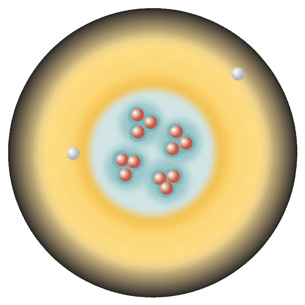Unit D
1. Unit D
Unit D Introduction
Introduction
The universe is so large that distance needs to be measured relative to the speed of light. For example, a photon travelling 300 million metres per second would take 100 000 years to cross from one side of the Milky Way galaxy to the other. For that photon to travel across the universe would take approximately 93 billion years, according to current estimates. Considering this, you might think that a photon travelling for an entire year would cover a great distance; but on the scale of the universe, it would hardly appear to be moving at all. Knowing this helps you understand how small Earth and its inhabitants are relative to what some consider the infinitely large space of the universe. On this scale you wouldn’t even know Earth existed, let alone be able to find it.
Humans have learned all of this by looking outward at larger things beyond the familiar surroundings of the planet Earth. Now imagine what humans could learn by looking inward at smaller and smaller scales. Can you look inward as far as you can look outward? If you could, what would you see and find? These are deep questions. Consider the journey inward as it is illustrated below, as you zoom in from the universe to the level of a subatomic particle.
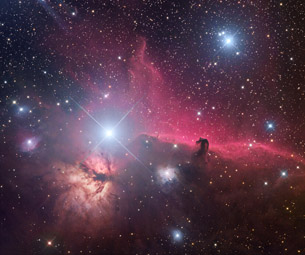
© Giovanni Benintende/shutterstock
Using extensive technology and observations, humans have learned that the universe comprises vast amounts of matter, with only about 4% of it visible in stars and gas clouds.
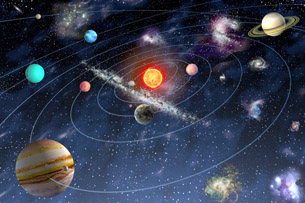
© Jurgen Ziewe/shutterstock
With less powerful technology, the solar system is observable. It occupies an infinitesimally small place relative to the universe and is composed of various planets orbiting a single star.
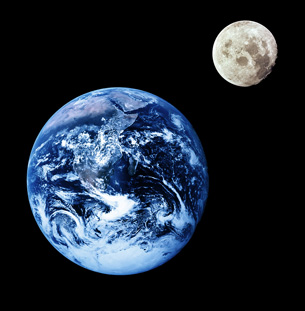
© pjmorley/shutterstock
Looking inside the solar system, Earth is just one of many planets.

© PaulPaladin/shutterstock
Earth is surrounded by a very thin atmosphere.

© Todd Hackwelder/shutterstock
Inside the atmosphere and near Earth’s surface, there is an abundance of gas, liquid, and solid matter.

© Aleksandar Milosevic/shutterstock
Viewed up-close using only the human eye, water can be seen collecting at the end of a leaf.
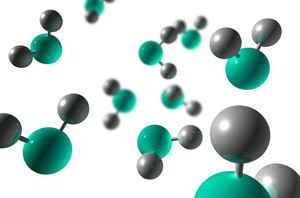
© Sai Yeung Chan/shutterstock
Because of extensive technology and experimentation, the water at the end of the leaf is known to be composed of many small molecules.
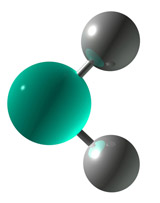
© Sai Yeung Chan/shutterstock
Each water molecule, in turn, is composed of smaller components called atoms.
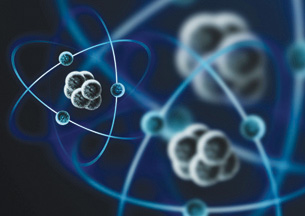
© James Thew/shutterstock
With even more extensive technology and theoretical knowledge, scientists have determined that the atom comprises smaller particles, called electrons, protons, and neutrons.
Looking even deeper, scientists have found that the protons, electrons, and neutrons are, in turn, made of even smaller particles called quarks.
?
Is there any reason we can’t look deeper? Is there any reason to suspect that quarks are, in turn, made of something smaller?
In Unit D you will investigate atomic physics. You may have noticed that the molecules, atoms, and subatomic particles are illustrations instead of photos. It is important to know that, where reasonable, these illustrations only show an artistic impression of models and theories that are used to describe complex ideas; they do not necessarily provide an accurate representation of the reality. Recall from Module 6: Lesson 3 that a microscope’s magnification is limited by the size of the wavelength (or de Broglie wavelength) used to produce the image. To study atomic physics at a scale beyond the resolving power of any microscope (matter or optical), new tools, theories, models, and technology need to be deployed.
In Module 7 you will look at the experiments that established quantum theory. You will see how J.J. Thomson’s charge-to-mass ratio of the electron established proof that the atom is not the smallest particle of matter and led to a new model of the atom. You will see how Millikan used an electric field apparatus to measure the charge on an individual electron, and how the results of Rutherford’s alpha particle scattering from gold foil shocked him and led to our understanding of the nucleus of the atom. Finally you will look at Bohr and how spectroscopy of hydrogen gas led to the establishment of the Bohr model of the atom to unify the experimental data of the time into a model of the atom.
In Module 8 you will see how modern physics has developed. You will learn about the nuclear reactions of fission and fusion, how to write the nuclear equation, how the rate of nuclear reactions allows us to determine the products and age of a sample, how nuclear reactions have led to the discovery of more and more subatomic particles, and the theory to describe the atom.
In this unit you will discover how experimental evidence has been gathered and interpreted to build an understanding of how the atom is organized. By the end of this unit you will understand the electrical nature of the atom and the quantization of energy in the atom and nucleus. You will also understand the application of this knowledge in technologies related to nuclear energy, atomic research, and nuclear imaging.
Essential Questions
- What is the electrical nature of the atom?
- How is it possible to investigate the nature of the atom?
- What experimental evidence supports the theory that energy is quantized in atoms and nuclei?
- How has the knowledge of atomic and subatomic structure been utilized in the development of new technology?
